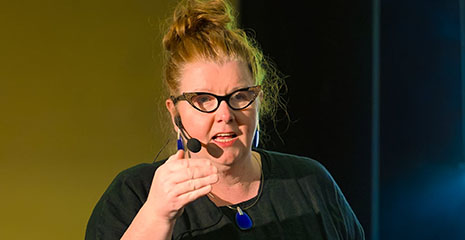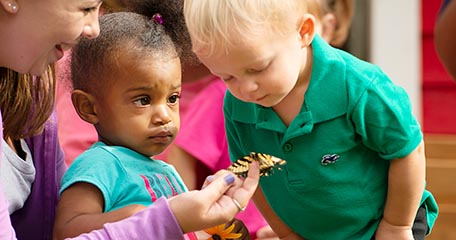Great expectations
| June 2012In a magazine piece I recently read about a Kenyan school that holds its classes in a shady grove outdoors, the headmaster (who had helped plant the trees as a child) recalled an African saying: “When you plant a tree, never plant only one. Plant three – one for shade, one for fruit, and one for beauty.” On a continent where heat and drought make every tree valuable, that’s wise advice. It’s an intriguing educational insight too, especially in a time like ours, when vast numbers of children are endangered by a one-sided approach that sees them solely in terms of their ability to be fruitful – that is, to “achieve” and “succeed.”

The pressure to excel is transforming childhood as never before. Naturally, parents have always wanted their children to “do well,” both academically and socially. No one wants their child to be the slowest in the class, the last to be picked for a game on the field. But what is it about the culture we live in that has made that natural worry into such an obsessive fear, and what is it doing to our children? What is achievement, anyway? And what is success, other than some vague, lofty ideal?
My mother used to say that education begins in the cradle, and not one of today’s gurus would disagree. But the differences in their approach are instructive. Whereas women of her generation sang their babies to sleep just as their mothers had done – because a baby loves the sound of its mother’s voice – today’s tend to cite studies on the positive effects of Mozart on the development of the infant brain. Fifty years ago, women nursed their babies and taught their toddlers finger games as a matter of course; today, most do neither, despite endless chatter about the importance of bonding and nurture.
As an author I became aware, after completing my first book, of something I had never noticed previously: the importance of white space. White space is the room between the lines of type, the margins, extra space at the beginning of a chapter, a page left blank at the beginning of the book. It allows the type to “breathe” and gives the eye a place to rest. White space is not something you’re conscious of when you read a book. It is what isn’t there. But if it were gone, you’d notice it right away. It is the key to a well-designed page. Just as books require white space, so do children. That is, they need room to grow. Unfortunately, too many children aren’t getting that. In the same way that we tend to overwhelm them with material things, we tend to over-stimulate and over-steer. We deny them the time, space, and flexibility they need to develop at their own pace.
The ancient Chinese philosopher Lao-Tzu reminds us that “it is not the clay the potter throws that gives the jar its usefulness, but the space within.” Children need stimulation and guidance, but they also need time to themselves. Hours spent alone in daydreams or in quiet, unstructured activities instil a sense of security and independence and provide a necessary lull in the rhythm of the day. Children thrive on silence too. Without external distractions they will often become so consumed by what they are doing that they will be totally oblivious of everything around them. Unfortunately, silence is such a luxury that they are rarely allowed the opportunity for such undisturbed concentration. Whatever the setting – mall, elevator, restaurant, or car – the low murmur (or blare) of piped-in music or background noise is incessantly there.
As for the importance of giving children unstructured time, nineteenth-century writer Johann Christoph Blumhardt warns against the temptation to constantly intrude, and emphasises the value of spontaneous activity: “That is their first school; they are teaching themselves, as it were. I often have the feeling that angels are around children…and that whoever is so clumsy as to disturb a child provokes his angel.” Certainly there is nothing wrong with giving a child chores and requiring him to carry them out on a daily basis. But the way many parents overbook their children, emotionally and timewise, robs them of the scope they need to develop on their own.
I have always been regretting that I was not as wise as the day I was born.
It is a beautiful thing to see a child thoroughly absorbed in his play; in fact, it is hard to think of a purer, more spiritual activity. Play brings joy, contentment, and detachment from the troubles of the day. And especially nowadays, in our hectic, time- and money-driven culture, the importance of those things for every child cannot be emphasised enough. Educator Friedrich Froebel, the father of the modern kindergarten, goes so far as to say that “a child who plays thoroughly and perseveringly, until physical fatigue forbids, will be a determined adult, capable of self-sacrifice both for his own welfare and that of others.” In an age when fears of playground injuries and the misguided idea that play interferes with “real” learning has led some forty percent of the school districts across the country to do away with recess, one can only hope that the wisdom of these words will not go entirely unheeded.
Allowing children the room to grow at their own pace does not mean ignoring them. Clearly, the bedrock of their security from day to day is the knowledge that we who care for them are always at hand, ready to help them, to talk with them, to give them what they need, and simply to “be there” for them. But how often are we swayed instead by our own ideas of what they want or need?
After the massacre at Columbine High School in April 1999, administrators rushed to provide psychologists and counsellors to help traumatised students process their grief. But the teenagers didn’t want to see experts. Though many privately sought professional help later, on their own terms, they first flocked to local churches and youth centres, where they dealt with their grief by talking to their peers. The tendency to intervene, especially when a child is in trouble, is a natural one, but even then (perhaps especially then) it is vital to be sensitive to the child’s needs. That’s what Nicole, a mother of four, learned when their quiet English village was rocked by a savage murder:
In June 1996 a local woman and her daughter were beaten to death near the edge of our property, while walking home from the local elementary school. A second daughter was beaten too, though she survived. My daughters, who were six and eight, had often played with the girls, who were the same age. Days and nights of tears followed –in fact, my daughters still wept at intervals months after the incident.
As a mother, I was naturally worried about the traumatic effects of the crime, and the whereabouts of the murderer (who is still at large). I was tempted to question my children as to how they were doing and what they were thinking about the whole thing. But I tried to refrain. I knew that to help them, I needed to hear what they had to say – what their own spontaneous reactions were – and not impose or project my own motherly ideas on them first…
Amazingly, they never spoke once in fear of our neighbours� murderer, as every adult in the area was doing. Instead, they asked, “Why did that man hate them so much? They didn’t do anything to him…”
In the weeks after the murder, well-meaning friends repeatedly urged us to “move on.” “Don’t let your children get hung up on this gruesome event,” they warned us. “Help them get over it as quickly as possible.” But I couldn’t. At that point my children needed to grieve, and I could not bring myself to subject them to adult ideas about healing.
In Ordinary Resurrections, his book about children in the South Bronx, Jonathan Kozol reflects on another angle of the same issue: the way adults tend to guide children through even the most casual conversations. He says it, too, is a result of our tendency to hurry – and our reluctance to let them sort life out in their own way, at their own pace.
Children pause a lot when reaching for ideas. They get distracted. They meander – blissfully, it seems –through acres of magnificent irrelevance. We think we know the way they’re heading in a conversation, and we get impatient, like a traveller who wants to “cut the travel time.” We want to get there quicker. It does speed up the pace of things, but it can also change the destination.
Of all the ways in which we push children to meet adult expectations, the trend toward high-pressure academics may be the most widespread, and the worst. I say “worst” because of the age at which children begin to be subjected to it, and the fact that for some of them school quickly becomes a place they dread, and a source of misery they cannot escape for months at a time.
As someone whose scholastic career included plenty of mediocre grades, I am familiar enough with the dread that accompanies bringing home a report card. Thankfully, my parents cared far more about whether I got along with my peers than whether I achieved an A or a B. Even when I failed a class, they refrained from scolding me, and eased my anxieties by assuring me that there was a lot more in my head than I or my teachers realised; it just hadn’t come to the surface yet. According to Melinda, a veteran preschool teacher in California, such encouragement is only a dream for many children, especially in homes where academic failure is seen as unacceptable:
We have parents asking whether their two-and-a-half-year-olds are learning to read yet, and grumbling if they can’t. The pressure some parents put on children is just incredible. I see children literally shaking and crying because they don’t want to go in to testing. I’ve even seen parents dragging their child into the room…
I had a little boy one year, Miles, whose parents were pushing him to get him ready to enter a very expensive private school. I bumped into his father at the beginning of the next school year and he said, “You know, Miles has been so stressed out that we’re going to get him into counselling.” It was true that Miles was stressed out, but I was sure it was because of the rigorous testing they’d put him through during the summer…He had started crying the day of the testing, and he’d cried every day since then.
In some instances, the frenzy to compete begins even before a child is ready to start school, as this recent newspaper column about the trials of one New York City couple shows:
They got word that their five-year-old son had been skunked at all six private schools they applied to for next fall’s kindergarten class. “Don’t worry,” the head of their nursery school had assured them. “You will certainly get into at least one of your top choices.”
Famous last words. For whatever reasons, all six schools passed on their bright son with the winning smile and splendid test scores. That tattoo of rejection hurt, she admits. Nor did it help to learn that other families landed in the same boat. Now comes the hard part…do they move, reluctantly, out of town? Do they keep their son in nursery school for now and try the private-school rat race again next year? Do they sigh in resignation and send him to the local public school?
The dilemma facing this couple is a measure of how frantic life has become in a world of strivers. “People are twisting themselves inside out,” the woman said. “You slap yourself around and say, ‘It’s only kindergarten.’ We’re not talking about cancer. But it changes your life…Besides,” she added, “the parental community can be vicious… Your child’s admissions profile becomes a measure of your success. That’s the yuckiest part of it. These are babies we’re talking about.”
In the end, she said, she and her husband will probably keep their son in his present nursery and then go through the private-school drill once more, next year. “That’s what tears me up,” she said. “He has to be paraded like a show horse again.”
It’s true the examples above represent the extreme end of the spectrum. Still, they cannot be dismissed, because they shed light on a disturbing trend that affects education at all levels. More and more, it seems that we have lost sight of the “child” in childhood and turned it into a joyless training camp for the adult world. Jonathan Kozol writes:
From around the age of six or seven, and up to eleven or maybe twelve, the gentleness and honesty – the sweetness – of children is so apparent. Our society has missed an opportunity to seize that moment. It’s almost as though we view those qualities as useless, as though we don’t value children for their gentleness, but only as future economic units, as future workers, as future assets or deficits. When you read political debates on how much we should spend on children, you’ll notice that the argument usually has nothing to do with whether children deserve a gentle and happy childhood, but whether investment in their education will pay off economically twenty years later. I always think, why not invest in them simply because they’re children and deserve to have some fun before they die? Why not invest in their gentle hearts as well as in their competitive skills?
The answer, of course, is that we have abandoned the idea of education as growth, and decided to see it only as a ticket to the job market. Guided by charts and graphs, and cheered on by experts, we have turned our backs on the value of uniqueness and creativity and fallen instead for the lie that the only way to measure a child’s progress is a standardised test. Not only are we neglecting to plant trees for shade and beauty – we are planting for only one variety of fruit. Or, as Malvina Reynolds puts it in her song “Little Boxes”:
And they all play on the golf course,
and drink their martinis dry,
And they all have pretty children,
and the children go to school,
And the children go to summer camp,
and then to the university,
Where they put them all in boxes,
and they come out all the same.
Granted, children ought to be stretched and intellectually stimulated. They should be taught to articulate their feelings, to write, to read, to develop and defend an idea; to think critically. But what is the purpose of the best academic education if it fails to prepare children for the “real” world beyond the confines of the classroom? What about those life-skills that can never be taught by putting a child on a bus and sending him to school?
As for the things that schools are supposed to teach, even they are not always passed on. Writer John Taylor Gatto points out that though American children sit through an average of 12,000 hours of compulsory academic instruction, there are plenty who leave the system as 17- and 18-year-olds who still can’t read a book or calculate a batting average –let alone repair a faucet or change a flat.
It is not just schools that are pressuring children into growing up too fast. The practice of rushing children into adulthood is so widely accepted and so thoroughly ingrained that people often go blank when you voice your concern about the matter. Take, for example, the number of parents who tie up their children’s after-school hours in extracurricular activities. On the surface, the explosion of opportunities for “growth” in things like music and sports might look like the perfect answer to the boredom faced by millions of latchkey children. But the reality is not always so pretty. Tom, an acquaintance with friends in suburban Baltimore, says:
It’s one thing when a child picks up a hobby, a sport, or an instrument on her own steam, but quite another when the driving force is a parent with an overly competitive edge. In one family I know – I’ll call them the Joneses – Sarah showed a genuine talent for the piano in the second grade, but by the time she was in the sixth, she wouldn’t touch a keyboard for any amount of coaxing. She was tired of the attention, sick of lessons (her father was always reminding her what a privilege they were), and virtually traumatised by the strain of having been pushed through one competition after another. Yes, Sarah played Bach beautifully at seven. But at ten she was interested in other things.
In the case above, and countless others, the pattern is all too familiar: ambitious expectations are followed by the pressure to meet them, and what was once a perfectly happy part of a child’s life becomes a burden that is impossible to bear.
Einstein once wrote that if you want brilliant children, read them fairy tales. “And if you want them to be more brilliant, read them more fairy tales.” Obviously, such a quip is not the sort of answer an expert might give to the discouraging trends described above. But I still believe it is a thought worth reflecting on. It is the inventive sort of wisdom without which we will never pull ourselves out of the ruts we are currently stuck in.
As for the parental desire to have brilliant children in the first place, it is surely just another sign of our distorted vision – a reflection of the way we tend to view children as little adults, no matter how loudly we may protest such a “Victorian” idea. And the best antidote to that is to drop all of our adult expectations entirely, to get down on the same level as our children, to look them in the eye. Only then will we begin to hear what they are saying, to find out what they are thinking, and to see the goals we have set for them from their point of view. Only then will we be able to lay aside our ambitions and recognise, as poet Jane Tyson Clement puts it:
Child, though I am meant to teach you much,
what is it, in the end,
except that together we are
meant to be children
of the same Father,
and I must unlearn
all the adult structure
and the cumbering years
and you must teach me
to look at the earth and the heaven
with your fresh wonder.
“Unlearning” our adult mindsets is never easy, especially at the end of a long day, when children can sometimes seem more of a bother than a gift. When there are children around, things just don’t always go as planned. Furniture gets scratched, flower beds trampled, new clothes torn or muddied, toys lost and broken. Children want to handle things and play with them. They want to have fun, to run in the aisles; they need space to be rambunctious and silly and noisy. After all, they are not china dolls or little adults, but unpredictable rascals with sticky fingers and runny noses who sometimes cry at night. Yet if we truly love them, we will welcome them as they are.






